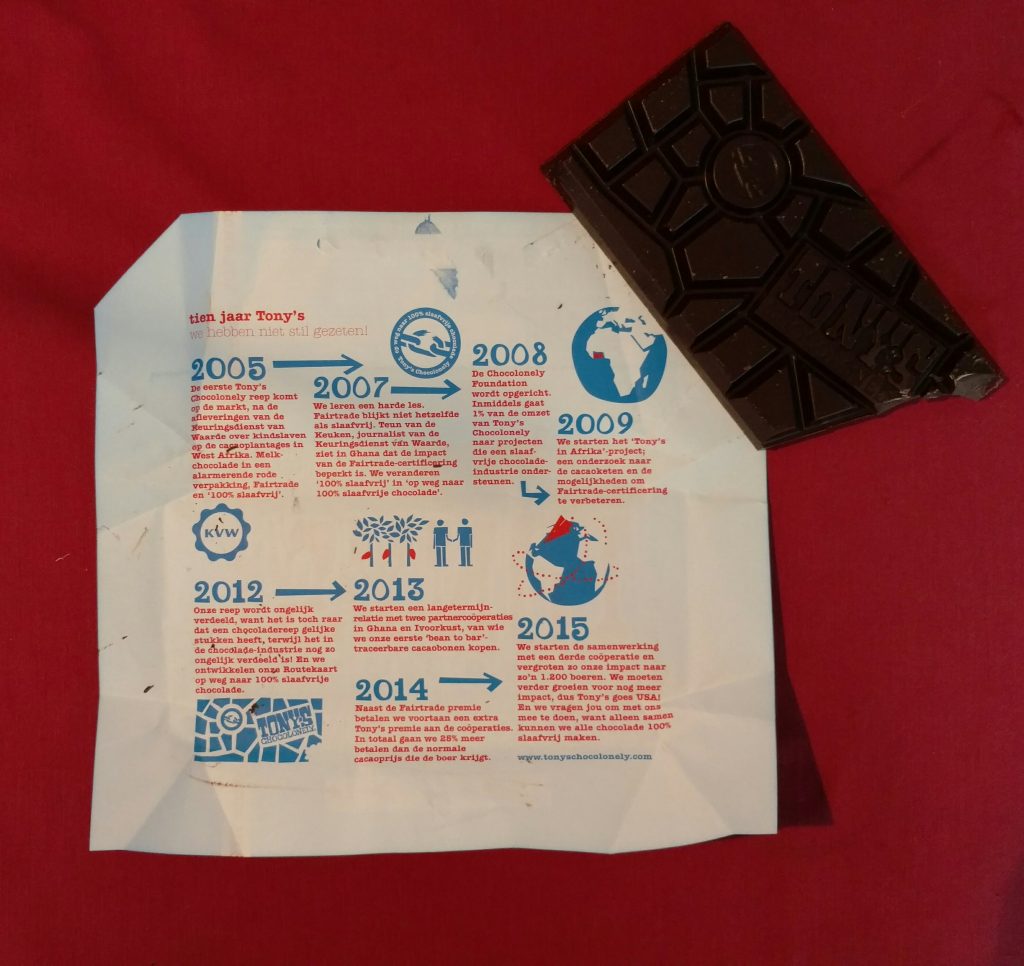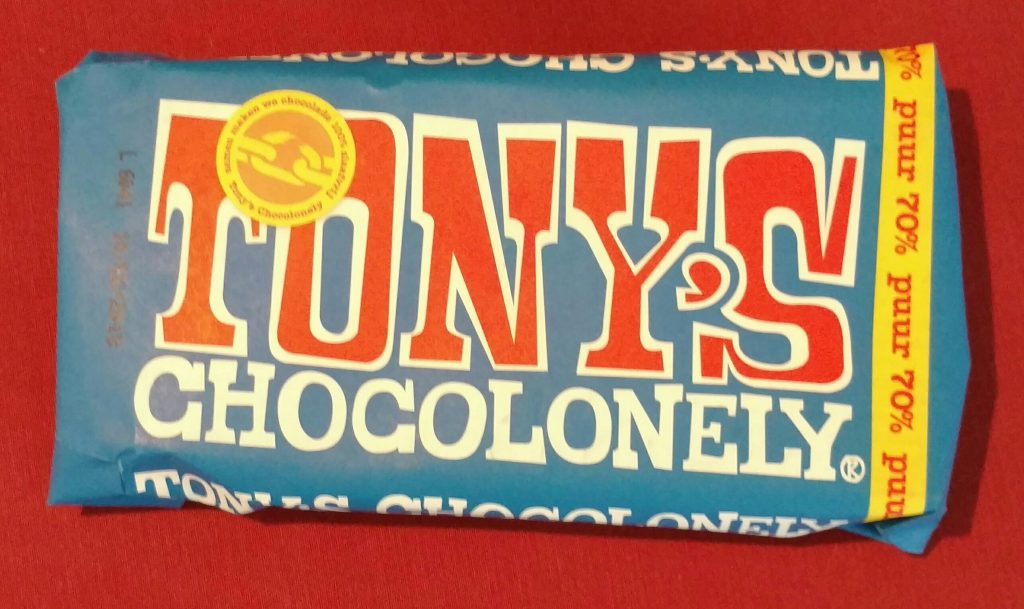Can You Say This Correctly? – 4: Tony’s Chocolonely Puur – Samenstellingen Posted by Sten on May 30, 2016 in Culture, Dutch Grammar, Dutch Language, Dutch Vocabulary
One of the hardest things about learning Dutch is pronunciation. Whether it is about the ui-klank (the “ui” sound), the G-klank (the “G” sound) or other sounds you might have a hard time with. This series, called “Can You Say This Correctly?”, is about providing a speech example that I recorded. I will give the Dutch text, a translation, and I will add one comment or more for parts that you have to heed for pronunciation. If there are any sounds that you would like to see a post about, let me know in the comments!
OTHER PARTS OF THE SERIES
Part 1: Arla Biologische Volle Melk – how to pronounce long and short vowels
Part 2: Innocent Goedgemutste Smoothie – How to pronounce ei, ij, ie, -je, -pje, -tje
Part 3: Tony’s Chocolonely Melk Passievrucht Yoghurt – how to pronounce the c
Part 5: Can You Say This Correctly? – 5: Fair Trade Basmatirijst – How to pronounce ij
Last week, we had a look at another type of Tony’s Chocolonely chocolate, and we discovered the difference in pronouncing the c. However, the chocolate brand has two different wikkels (wrappings), and today, we will have a look at the other one, displayed below. If you want to know more about Tony’s Chocolonely, check out our last post, or visit their website.

THE RECORDING
The recording of the Dutch text:
THE TEXT
Tien jaar Tony’s
We hebben niet stil gezeten!
Tweeduizendvijf (2005): De eerste Tony’s Chocolonely reep komt op de markt, na de afleveringen van de Keuringsdienst van Waarde over kindslaven op de cacaoplantages in West Afrika. Melkchocolade in een alarmerende rode verpakking, Fairtrade en ‘honderd procent (100%) slaafvrij’.
Tweeduizendzeven (2007): We leren een harde les. Fairtrade blijkt niet hetzelfde als slaafvrij. Teun van de Keuken, journalist van de Keuringsdienst van Waarde, ziet in Ghana dat de impact van de Fairtrade-certificering beperkt is. We veranderen ‘100% slaafvrij’ in ‘op weg naar 100% slaafvrije chocolade’.
Tweeduizendacht (2008): De Chocolonely Foundation wordt opgericht. Inmiddels gaat één procent (1%) van de omzet van Tony’s Chocolonely naar projecten die een slaafvrije chocolade-industrie ondersteunen.
Tweeduizendnegen (2009): We starten het ‘Tony’s in Afrika’-project; een onderzoek naar de cacaoketen en de mogelijkheden om Fairtrade-certificering te verbeteren.
Tweeduizendtwaalf (2012): Onze reep wordt ongelijk verdeeld, want het is toch raar dat een chocoladereep gelijke stukken heeft, terwijl het in de chocolade-industrie nog zo ongelijk verdeeld is! En we ontwikkelen onze Routekaart op weg naar 100% slaafvrije chocolade.
Tweeduizenddertien (2013): We starten een langetermijnrelatie met twee partnercoöperaties in Ghana en Ivoorkust, van wie we onze eerste ‘bean to bar’-traceerbare cacaobonen kopen.
Tweeduizendveertien (2014): Naast de Fairtrade premie betalen we voortaan een extra Tony’s premie aan de coöperaties. In totaal gaan we vijfentwintig procent (25%) meer betalen dan de normale cacaoprijs die de boer krijgt.
Tweeduizendvijftien (2015): We starten de samenwerking met een derde coöperatie en vergroten zo onze impact naar zo’n twaalfhonderd (1200) boeren. We moeten verder groeien voor nog meer impact, dus Tony’s goes USA! En we vragen jou om met ons mee te doen, want alleen samen kunnen we alle chocolade 100% slaafvrij maken.
THE TRANSLATION
Ten years Tony’s
We didn’t sit still!
2005: The first Tony’s Chocolonely bar enters the market, after the episodes of the Keuringsdienst van Waarde (= Inspection Authority of Value, a Dutch TV program investigating problems with products) about child slavery on cocoa plantations in West Africa. Milk chocolate in an alarming red wrapping, Fairtrade and ‘100% slave-free’.
2007: We learn a hard lesson: Fairtrade appears not to be the same as slave-free. Teun van de Keuken, journalist of the Keuringsdienst van Waarde, sees in Ghana that the impact of the Fairtrade certification is limited. We change ‘100% slave-free’ into ‘towards 100% slave-free chocolate’.
2008: The Chocolonely Foundation is founded. In the meantime, 1% of the revenue of Tony’s Chocolonely goes to projects that support a slave-free chocolate industry.
2009: We start the ‘Tony’s in Africa’ project; a study of the cocoa chain and the possibilities to improve the Fairtrade certification.
2012: Our bar is split unequally, because it is indeed strange that a chocolate bar has equal pieces, even though it is so unequally divided in the chocolate industry! And we develop our Route map towards 100% slave-free chocolate.
2013: We start a long-term relationship with two partner cooperatives in Ghana and Ivory Coast, from whom we buy our first ‘bean to bar’ traceable cocoa beans.
2o14: Besides the Faitrade premium, we pay an additional Tony’s premium to the cooperatives from now on. In total, we will pay 25% more than the normal cocoa price that the farmer receives.
2015: We start the cooperation with a third cooperative and enlarge our impact to about 1200 farmers. We have to grow further for an even larger impact, so Tony’s goes USA! And we ask you to join us, because only together we can make all chocolate 100% slave-free.
COMMENTS
cacaoplantages
Cacaoplantage is a good example of how samenstellingen (compounds) are made in Dutch. Unlike for example in English, where often words are written with spaces in between, in Dutch, words are glued together. Much like in German. But also a little less, which will become clear from the other comments below!
So, the standard rule in Dutch for samenstellingen is to just glue words together, as long as they are “real words” by themselves. Cacaoplantage, chocoladereep, cacaoboter, and so on. The word slaafvrij, the neologism we discussed in the last post about Tony’s Chocolonely, is also a samenstelling made of the words slaaf and vrij.
Words where not both parts are “real”, regenachtig (rainy), for example, is not a samenstelling, as -achtig is not a word by itself, though regen (rain) is.
Fairtrade-certificering
There are samenstellingen where a streepje (hyphen) is required, which we will see below. However, you can use a streepje in many cases, just if you want to clarify the uitspraak (pronunciation) of a word. In the case of Fairtradecertificering, this may not be required, but it still, Fairtrade-certificering is easier to read. Therefore, it is fine to use a streepje. Another great example of where a streepje could make a difference, but is not written with one, is the word pollepel (wooden spoon). It could be pronounced like this:
But it is actually pronounced as if there was a streepje (pol-lepel):
And please, do not use a streepje for very short, simple samenstellingen, such as voetbal. Voet-bal just doesn’t feel right!
chocolade-industrie
There are also those samenstellingen where you are required to use a streepje. Chocolade-industrie is an example, as there is klinkerbotsing (“vowel clashing”) if you leave the streepje out: Chocoladeindustrie, listen to the recording of how that would sound here:
There are many other examples where such klinkerbotsing takes place, and would change the uitspraak if a streepje is not used. For a list of situations where a streepje is required, check out this link, under the header Samenstellingen.
partnercoöperaties
Another type of compounds where a klinkerbotsing may occur – which are not called samenstellingen, but afleidingen (morphological derivation) – require the use of a trema (diaeresis, also known as umlaut from German or simply tréma). This does the same as the streepje above in chocolade-industrie, just that for afleidingen, a trema is used. Simple as that. The purpose is the same.
In this case, of course partnercoöperaties is a samenstelling of partner and coöperaties. So the word we are specifically looking at here is coöperaties.
Again, here is what partnercooperaties (so without the trema) sounds like:
Other examples are beïnvloeden (to influence) or beëindigen (to end). The ï and ë are actually used most to prevent klinkerbotsing in afleidingen.
‘Tony’s in Afrika’-project; ‘bean to bar’-traceerbaar
These samenstellingen are formed using a word group and connecting that group with another word to form a samenstelling. Officially, a streepje is not required, so Tony’s in Afrikaproject is correct. Also bean to bartraceerbare would be correct, however a streepje is advisable here, since this is an English word group mixed with Dutch, and a streepje can make this distinction clearer. Also, the fact that these are slogans, the streepje makes this clearer. Since Tony’s in Afrika and bean to bar originally don’t have streepjes in between the words, you shouldn’t add any. So, Tony’s-in-Afrika and bean-to-bar are incorrect.
MISTAKES
Fairtrade premie, West Afrika
In the same text, Tony’s Chocolonely made a mistake on this specific topic! Now, without giving away the answer to the mistakes and keeping in mind what I wrote above, let me know in the comments what you think the right way of writing Fairtrade premie and West Afrika is. You can also send me your answer in a Facebook message by clicking on the button below. The answer will appear on Thursday on our Facebook page!
Of course, you can also reach us for any other question, comment or remark you might have.

Build vocabulary, practice pronunciation, and more with Transparent Language Online. Available anytime, anywhere, on any device.
About the Author: Sten
Hi! I am Sten, both Dutch and German. For many years, I've written for the German and the Dutch blogs with a passion for everything related to language and culture. It's fascinating to reflect on my own culture, and in the process allow our readers to learn more about it! Besides blogging, I am a German-Dutch-English translator, animator and filmmaker.





